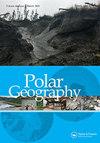Cool, CALM,收集:环极有源层监测程序和网络
IF 1.6
Q3 GEOGRAPHY, PHYSICAL
引用次数: 3
摘要
环极活动层监测(CALM)计划是主要的全球变化监测计划,涉及永久冻土以上的季节性冻结活动层。活动层已被全球气候观测系统和全球陆地观测网指定为“基本气候变量”。CALM于1991年在与国际冻土带实验合作的志愿基础上发起。自1998年以来,俄罗斯和阿拉斯加的CALM天文台一直得到美国国家科学基金会连续五个五年资助周期的支持。在其目前的配置中,CALM网络包括整个环北极地区的观测点和南极洲的大量观测点。对数据的开放访问和数据协调是该计划的标志。除了持续强调对活动层厚度、温度、土壤湿度和融化沉降的现场观测外,目前正在许多地点进行监测。越来越重视观察其他景观和生态系统参数的动态,包括植被、景观格局和土壤。该项目的其他发展特点包括扩大教育和推广活动,与其他国际项目密切合作,提供质量控制的标准化数据产品,以满足更广泛的科学界的需要。本文章由计算机程序翻译,如有差异,请以英文原文为准。
Cool, CALM, collected: the Circumpolar Active Layer Monitoring program and network
ABSTRACT The Circumpolar Active Layer Monitoring (CALM) program is the primary global-change monitoring program concerned with the seasonally frozen active layer above permafrost. The active layer has been designated by the Global Climate Observing System and the Global Terrestrial Observing Network as an ‘Essential Climate Variable’. CALM was launched in 1991 on a volunteer basis in cooperation with the International Tundra Experiment. CALM observatories in Russia and Alaska have been supported since 1998 by the U.S. National Science Foundation through five consecutive five-year funding cycles. In its current configuration, the CALM network includes observation sites throughout the circum-Arctic region and a substantial number of sites in Antarctica. Open access to data and data harmonization are hallmarks of the program. In addition to its ongoing emphasis on field observations of active-layer thickness, temperature, soil moisture, and thaw subsidence are currently being monitored at many sites. Increased emphasis is being placed on observing the dynamics of other landscape and ecosystem parameters, including vegetation, landscape patterns, and soils. Other developing features of the program include expanded education and outreach activities, close cooperation with other international programs, and provision of quality-controlled, standardized data products that meet the needs of the wider scientific community.
求助全文
通过发布文献求助,成功后即可免费获取论文全文。
去求助
来源期刊

Polar Geography
GEOGRAPHY, PHYSICAL-
CiteScore
5.30
自引率
0.00%
发文量
13
期刊介绍:
Polar Geographyis a quarterly publication that offers a venue for scholarly research on the physical and human aspects of the Polar Regions. The journal seeks to address the component interplay of the natural systems, the complex historical, political, economic, cultural, diplomatic, and security issues, and the interchange amongst them. As such, the journal welcomes comparative approaches, critical scholarship, and alternative and disparate perspectives from around the globe. The journal offers scientists a venue for publishing longer papers such as might result from distillation of a thesis, or review papers that place in global context results from coordinated national and international efforts currently underway in both Polar Regions.
 求助内容:
求助内容: 应助结果提醒方式:
应助结果提醒方式:


